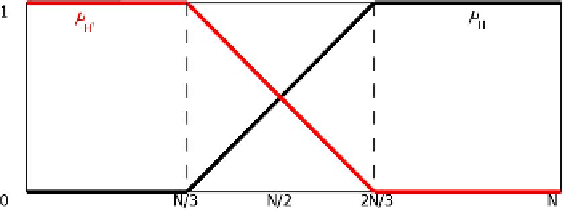Information Technology Reference
In-Depth Information
That is, depending on the chosen particular model for representing 'small', and
either on the negation N, or the symmetry
, the points s and B can change.
Of course, this variation is context-dependent on the concrete ways of using
'small', 'not small', and 'big'.
6. Provided the predicate P were crisp, then
α
X
μ
P
∈{
0
,
1
}
and
μ
P
(
x
)
≥
μ
not P
(
x
)=
1
−
μ
P
(
x
)
is equivalent to
μ
P
(
x
)
≥
1
/
2
, that is,
μ
P
(
x
)=
1
. Thus in these cases
the kernel is K
1
−
id
(
μ
P
)=
{
x
∈
X
;
μ
P
(
x
)=
1
}
, that is, it is just the subset speci-
fied by P in X .
15.4
Approaching the Use of the Term 'heap'
15.4.1
Like a correct linguistic use of the term 'small' in
requires to recognize, for
instance, that '1 is small' and that '9 is big' or at least, that '9 is not small', also
the use of the term 'heap' requires to recognize when something is not a heap, or
that it is a 'flat'. Additionally, it should be known on which universe of discourse
the term heap is applied to. Notice that, for instance, to correctly use the term 'odd'
it is needed to know if it is being applied to the universe of the positive integers. In
this way, the use of the word heap can be well learned, like it is learned the use of
small, or that of odd.
Under the typical philosophical hypothesis that a heap h only depends on the
number of grains it contents, and by taking a sufficient big number N of grains, let
us suppose that the universe is the interval
[
0
,
10
]
and that the degree up to which
h is a heap can be described by the picewise linear function in the figure (15.6), in
which it is clear that the threshold s is s
[
0
,
N
]
=
/
2
and K
1
−
id
(
μ
)=(
/
,
]
N
N
2
N
[8]. Of
H
course, in this case it is B
=
2
N
/
3
. For instance, if it were N
=
2
.
500
.
000
, it will be
s
=
834
.
000
, and B
=
1
.
666
.
667
, grains of sand.
Fig. 15.6


